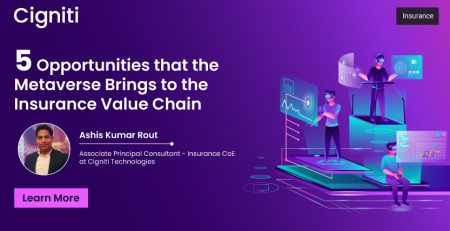Top tech trends disrupting the Insurance sector
Customer expectations are continuously changing, while the technological evolution is grabbing an accelerated pace. By the end of next decade, nearly half of the adult population will constitute millennials and post-millennials, making up for a population that is digital native.
With high expectations for omnichannel, integrated, digital experience across a brand’s value chain, these digital natives are compelling insurance brands to embrace the digital disruption. However, the insurers cannot completely swing in the digital direction as they also have to consider the other half of population, which is not as digital and tech-savvy. Therefore, the future strategy for the insurance industry cannot be entirely digital. Instead, they need to take a customer-centric approach.
Although the pandemic has played a key role in speeding up the digital disruption process in the insurance sector, it was not entirely unprecedented. As customer interactions with the insurance providers shifted online, the industry is getting forced to transform its old school processes.
As the insurance landscape tries to keep up with this disruptive evolution, a few technologies are emerging to be the key players. Let us have a look at the top technology trends that are shaping the tomorrow of the insurance sector.
1. Legacy IT modernization
To inculcate speed, simplicity, transparency, and customization into their services, the insurers need to overhaul their core legacy IT infrastructure. Legacy IT systems are the biggest challenge that has been hindering the digital progress of the insurance sector. Not only are they incompatible with the modern technologies but also incur high maintenance costs for the insurance organizations. Therefore, legacy IT modernization is not only a trend but a necessity for the insurers looking to take a digital-first approach for their services.
2. Augmented analytics
As per an estimate by the McKinsey Global Institute, artificial intelligence and advanced analytics (AA) could create $1.1 trillion in value for the insurance industry, representing almost 17 percent of the industry’s current total global revenues. With many insurance providers now deploying telematics and leveraging IoT devices and sensors to gather consumer data, augmented analytics is all set to become big in the industry.
3. AI and RPA
Simple RPA bots and AI-driven cognitive automation are expected to attract heavy investment from leading insurers. With the help of these next-gen technologies, insurance providers can automate and accelerate laborious and time-consuming activities such as claims processing and document verification. Instead of taking over the insurance personnel, AI and RPA will create an environment of efficiency and productivity, where humans and machines will work collaboratively to deliver enriched customer experiences. While AI-driven processes can speed up the otherwise tedious processes, human resources can check for the AI blind spots and ensure maximum efficacy at the end. They will enable the overhauling of specialized processes like fraud prevention, underwriting, anti-money laundering, and pricing, while offering enhanced personalization in customer service.
4. Multichannel communication
As the insurance sector needs to balance the needs of both digital natives and digital-reluctant population, it will have to employ multichannel communication. By employing smart technologies, insurers can tailor personalized packages for their customers and communicate to the customers through their preferred channel. With the help of deployed telematics and IoT sensors as well as augmented analytics applications, the insurance providers can have a digital dialogue with their customers in real-time. With the help of this data, they can bring in predictive capabilities to their service offerings, which would further enrich the experience and convenience of the customers.
To sum up
A new McKinsey survey revealed that over 65% of consumers intend to continue habits they adopted during crisis, such as new shopping methods. This means, the insurance industry needs to understand the direction of the wind’s flow and embrace smarter means of delivering services to the customers.
Cigniti supports global insurers in their digital transformation journey & helps them deliver improved customer experience & gain competitive advantage. We make sure your apps/systems run seamlessly by ensuring efficient back-office operations. Our testing services for insurance industry are backed by a portfolio and matchless track record that prove us as a trusted advisor and preferred technology partner for the Insurance clients.
The key focus areas of Cigniti’s Insurance TCoE are Reporting, Finance & Accounting, Claims management, Policy administration, & Underwriting across different segments of Insurance sector – Life, P&C, Auto, Business, Marine, Home, Agri, Travel, Re-insurance, and more.
Armed with industry-recognized certifications in Life and Non-Life insurance domains, our experts have experience in regulatory testing specific to various geographies including State-based Insurance Regulatory System, Federal Regulation of Insurance, National Association of Insurance Commissioners (NAIC), ABI, IRDA, IRTA, & Unclaimed Property Act (UPA).
Engage with our insurance domain testing experts and position your organization for success.





Leave a Reply